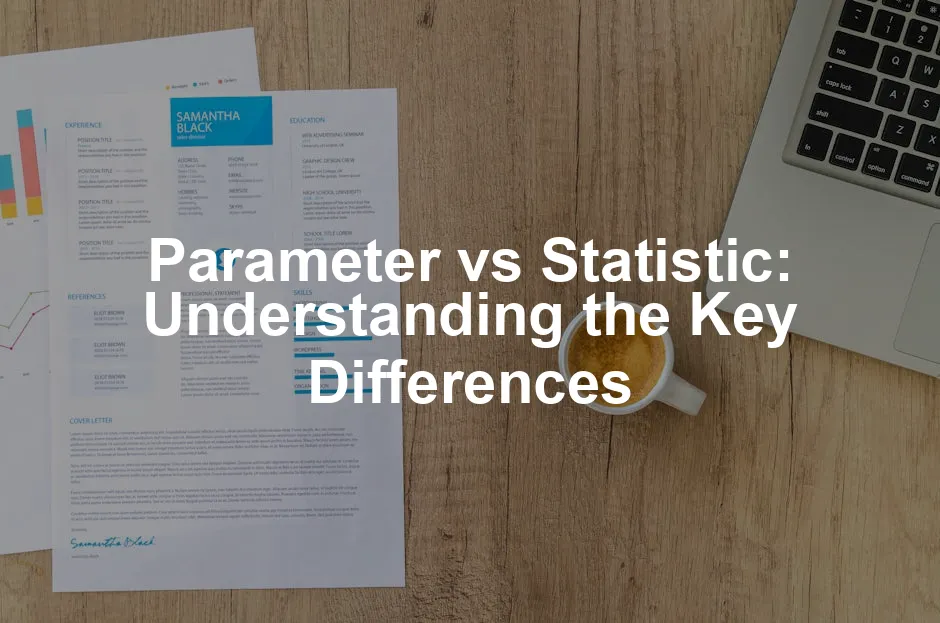Introduction
Parameters and statistics are fundamental concepts in statistics. Parameters describe entire populations, while statistics focus on samples. Understanding these distinctions is crucial for accurate data analysis. Misinterpretation can lead to flawed conclusions, affecting research and decision-making.
To enhance your statistical knowledge, consider reading The Art of Statistics: Learning from Data by David Spiegelhalter. It offers a witty and insightful perspective on how to analyze data effectively, making it a must-read for budding statisticians.
Summary and Overview
A parameter is a fixed numerical value representing a characteristic of a population. For example, the average height of all adult males in a country is a parameter. Conversely, a statistic is derived from a sample, not the entire population, and estimates characteristics of that population. For instance, the average height calculated from a sample of 1,000 adult males is a statistic.
The relevance of both terms extends across research and data analysis fields. Parameters provide exact measures, while statistics help estimate these parameters when complete data is impractical. The key distinction lies in their scope—parameters represent complete populations, while statistics reflect samples. Misunderstanding these terms can lead to inaccurate interpretations and conclusions.
If you’re looking to dive deeper into statistical concepts, check out Naked Statistics: Stripping the Dread from the Data by Charles Wheelan. This book makes statistics approachable and enjoyable, perfect for those who might feel intimidated by numbers.
What is a Parameter?
A parameter is a fixed numerical value that describes a characteristic of an entire population. This includes measures like population mean, variance, and proportion. For instance, consider the average income of all citizens in a country. This average income is a parameter since it represents a characteristic of the entire population.
Parameters are essential because they provide definitive values for population characteristics. They remain constant unless the population itself changes. Typical examples include:
- Population Mean (μ): The average income of all citizens.
- Population Standard Deviation (σ): The variability of heights among all adults in a region.
- Population Proportion (P): The percentage of voters supporting a candidate in an entire election.
In practical scenarios, parameters are often difficult to measure directly due to the size of populations. For instance, determining the exact average weight of every adult in a country is impractical. Instead, researchers estimate parameters using sample data.
Parameters help researchers understand the complete picture of a population. They serve as benchmarks against which statistics from samples can be compared. This comparison allows researchers to infer insights about the population based on limited data.
Think of parameters in your research context. How could knowing a population parameter enhance your understanding of your study? Recognizing the importance of parameters can transform your approach to data analysis, paving the way for more informed conclusions and decisions.
Don’t forget to equip yourself with the right tools for data analysis, like a reliable Graphing Calculator. This handy device is a game-changer for visualizing complex data and performing calculations quickly.
Understanding Population Parameters
Population parameters are fixed numerical values that describe characteristics of an entire population. They are essential for statistical analysis because they offer exact measures that researchers aim to estimate. For example, the average height of all adult males in a country is a population parameter. This value does not change unless the entire population itself changes.
In statistical analysis, parameters represent the true values of a population. Knowing these values helps researchers draw accurate conclusions and make informed decisions. However, measuring every member of a population is often impractical. Therefore, we typically rely on sample data to estimate these parameters.
Common notations for parameters include Greek letters, such as:
- μ (Mu): Represents the population mean.
- σ (Sigma): Denotes the population standard deviation.
- P: Indicates the population proportion.
These notations serve as a shorthand for communicating important statistical information. Understanding population parameters is crucial for anyone involved in research or data analysis.
What is a Statistic?
A statistic is a numerical value calculated from a sample. Unlike parameters, which describe entire populations, statistics focus on subsets of data. This distinction is vital for understanding how we interpret data and make inferences about larger groups.
For example, if you survey 500 people about their favorite ice cream flavor and find that 60% prefer chocolate, this percentage is a statistic. It’s derived from a sample of the population rather than the entire group. Statistics help us estimate population parameters when it’s impractical to measure every individual.
Statistics exhibit variability based on the sample selected. Different samples can yield different statistics, which highlights the importance of random sampling. This variability is crucial for making estimates and understanding the margin of error.
In various domains, statistics play a significant role. In healthcare, statistics might measure the efficacy of a new treatment based on a sample of patients. In marketing, businesses often analyze statistics from focus groups to gauge consumer preferences.
Consider how statistics are reported in the media. Often, you’ll encounter statements like “70% of Americans support a new policy.” While this figure sounds definitive, it’s crucial to recognize it stems from a sample statistic, not a population parameter.
Reflect on the statistics you encounter in media or research. How do they influence your understanding of various topics? Being aware of the difference between parameters and statistics allows for more informed interpretations of data.
Importance of Sample Statistics
Statistics play a vital role in understanding populations. They allow researchers to make educated guesses about large groups based on smaller samples. This process is known as statistical inference. When it’s impractical to collect data from an entire population, sample statistics fill the gap. For instance, if you want to know the average height of adults in a country, measuring every individual is nearly impossible. Instead, you can take a sample, calculate its average height, and use that to estimate the population mean.
In mathematical terms, sample statistics are often represented by symbols like 𝑥̄ for the sample mean and s for the sample standard deviation. These notations help differentiate between population parameters and sample statistics, making communication clearer among researchers. By understanding and using sample statistics, we can derive valuable insights without needing exhaustive data collection.
Statistical inference is crucial for estimating population parameters based on sample data. Learn more about this process in our guide on statistical inference for estimation in data science colorado.
Key Differences Between Parameter and Statistic
Understanding the differences between parameters and statistics is essential for anyone working with data. Here’s a quick breakdown:
- Population vs. Sample: A parameter describes an entire population, whereas a statistic is derived from a sample. For example, the average income of all citizens in a country is a parameter, while the average income calculated from a survey of 1,000 citizens is a statistic.
- Constancy vs. Variability: Parameters are fixed values; they don’t change unless the population does. In contrast, statistics can vary depending on the sample taken. This variability can lead to different estimates for the same parameter if different samples are used.
- Practical Applications: Parameters are often hard to obtain. Researchers use statistics to estimate parameters and draw conclusions about populations. This is crucial in fields like public health, where it’s often impossible to collect data from every individual.
Recognizing these differences can enhance your understanding of data. Take a moment to think about how these concepts apply in real-world situations you encounter. How do you see parameters and statistics being used in your everyday life?
Examples of Parameters and Statistics
Understanding the difference between parameters and statistics is much easier with real-world examples. Let’s look at a few scenarios.
In election polling, the percentage of all registered voters supporting a candidate is a parameter. For example, if 60% of voters in a state support a candidate, this figure reflects the entire population. However, when a pollster surveys only 1,000 voters to predict this outcome, the resulting percentage is a statistic. It estimates the parameter based on a smaller sample.
In health studies, consider the average blood pressure of all adults in a country. This average is a parameter. If researchers measure the blood pressure of 500 adults, the average they calculate is a statistic. It provides insight into the larger population based on limited data.
Another example is in the retail sector. The average amount spent by all customers in a store is a parameter. Conversely, if a store analyzes spending habits of 100 customers, the average from this group is a statistic.
These examples illustrate how parameters and statistics apply in different contexts. They show the importance of understanding each term as it relates to data interpretation.
What other examples can you think of in your daily life? Reflect on how you see parameters and statistics being used around you.
To further explore the realm of statistics, consider picking up Statistics for Dummies by Deborah J. Rumsey. This book breaks down complex statistical concepts into bite-sized pieces, making it a fantastic resource for beginners.
Statistical Notations and Symbols
Understanding the notations for parameters and statistics is essential in statistical reporting. Each type has specific symbols that help convey information efficiently.
For parameters, common notations include:
- μ (Mu): Represents the population mean.
- σ (Sigma): Denotes the population standard deviation.
- P: Indicates the population proportion.
On the other hand, statistics use different symbols:
- 𝑥̄: Represents the sample mean.
- s: Denotes the sample standard deviation.
- p̂ (p-hat): Symbolizes the sample proportion.
Recognizing these symbols is crucial for accurately interpreting statistical reports. They provide a quick reference for understanding the context of the data being presented.
To aid your understanding, consider creating a reference cheat sheet for these notations. It can simplify your analysis and help you grasp key concepts more easily.
If you’re looking for tools to assist with your data analysis, a good Statistical Software Package might be just what you need. These tools can streamline your data analysis process and make statistical computations a breeze.
Conclusion
In summary, understanding the difference between parameters and statistics is vital for accurate data interpretation. Parameters describe entire populations, providing fixed values, while statistics focus on samples and are subject to variability. Misunderstanding these terms can lead to flawed conclusions in research and decision-making. As you engage in future analyses, remember to apply this knowledge. It will enhance your ability to interpret data effectively, ensuring that your conclusions are well-founded. Embrace this distinction to elevate your analytical skills and drive better outcomes in your projects.
FAQs
What is the main difference between a parameter and a statistic?
A parameter describes an entire population, while a statistic summarizes a sample. For example, the average height of all adults (parameter) contrasts with the average height from a sample of 100 adults (statistic).
Why is it important to distinguish between parameters and statistics?
Distinguishing between these concepts ensures accurate research and data analysis. Misinterpretations can lead to incorrect conclusions, impacting decision-making and policy recommendations.
Can you provide examples of parameters and statistics?
A parameter example is the average income of all citizens in a country. A statistic example is the average income calculated from a sample of 1,000 citizens. Both represent similar measures but differ in their scope.
How do researchers use statistics to estimate parameters?
Researchers utilize statistical inference to estimate parameters based on sample data. By analyzing a representative sample, they can draw conclusions about the entire population.
What are common notations used for parameters and statistics?
Common notations include: Parameter Mean: μ, Parameter Standard Deviation: σ, Statistic Mean: 𝑥̄, Statistic Standard Deviation: s. These symbols help differentiate between population and sample measures.
To dive deeper into what constitutes a statistic, check out our comprehensive guide on what is a statistical question in math.
If you’re interested in advancing your data science skills, consider exploring Data Science for Business by Foster Provost and Tom Fawcett. This book bridges the gap between data analysis and business strategy, offering invaluable insights for professionals.
Please let us know what you think about our content by leaving a comment down below!
Thank you for reading till here 🙂















All images from Pexels




